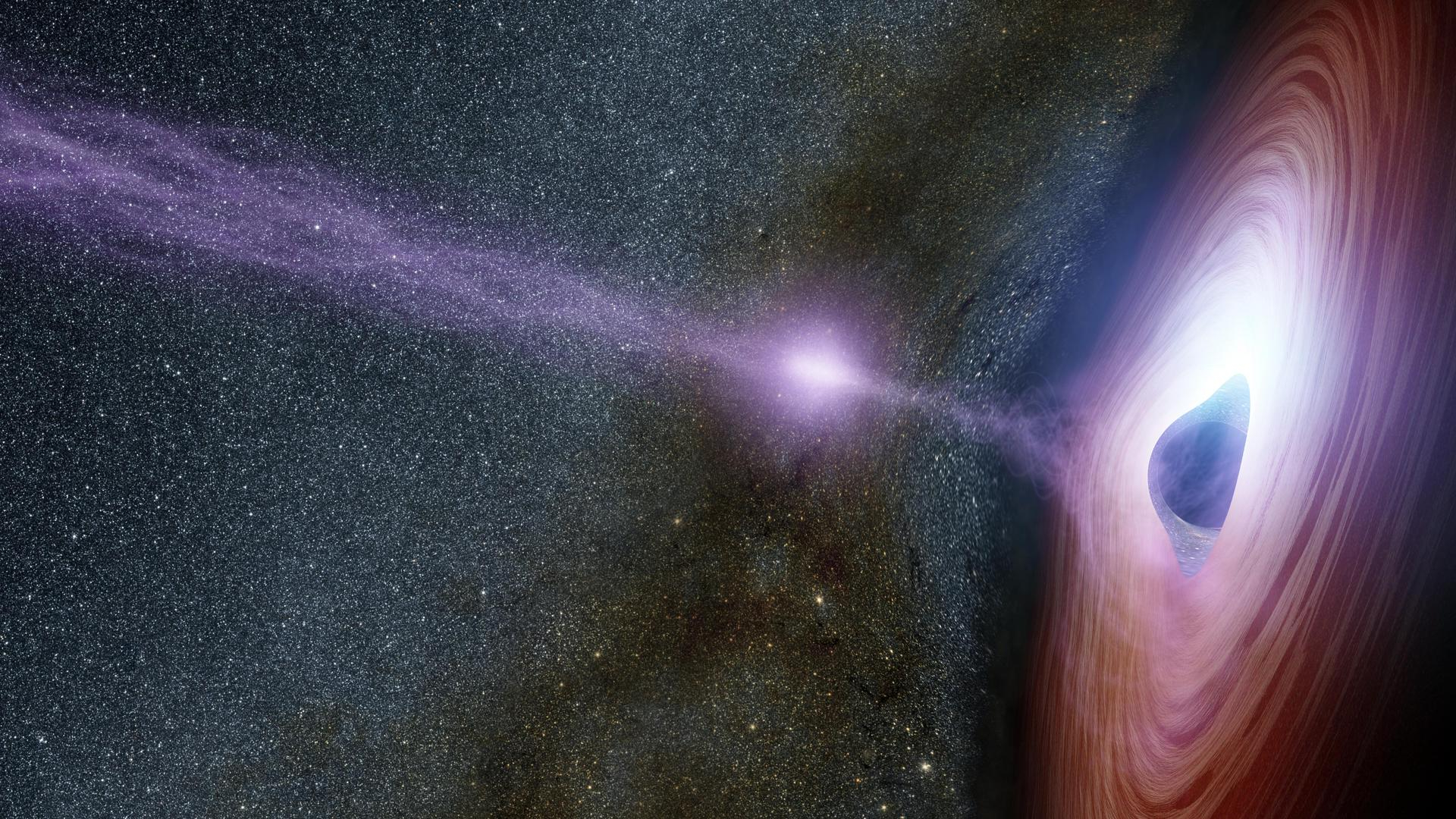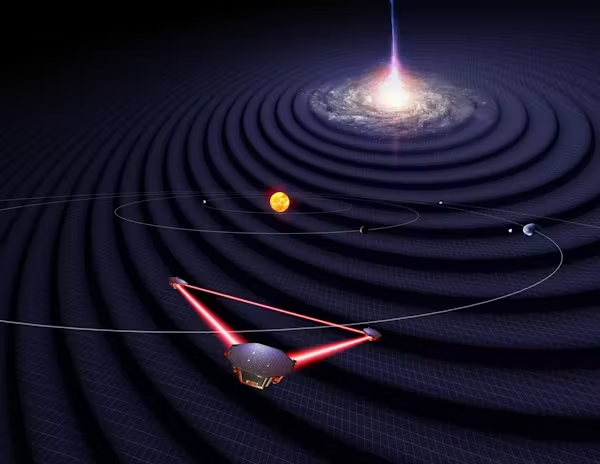
Black holes are mysterious, yet also deceptively simple − a new space mission may help physicists answer hairy questions about these astronomical objects
Physicists consider black holes one of the most mysterious objects that exist. Ironically, they’re also considered one of the simplest.

Physicists consider black holes one of the most mysterious objects that exist. Ironically, they’re also considered one of the simplest. For years, physicists like me have been looking to prove that black holes are more complex than they seem. And a newly approved European space mission called LISA will help us with this hunt.
Research from the 1970s suggests that you can comprehensively describe a black hole using only three physical attributes – their mass, charge and spin. All the other properties of these massive dying stars, like their detailed composition, density and temperature profiles, disappear as they transform into a black hole. That is how simple they are.
The idea that black holes have only three attributes is called the “no-hair” theorem, implying that they don’t have any “hairy” details that make them complicated.
Related: What is a black hole event horizon (and what happens there)?
Hairy black holes?
For decades, researchers in the astrophysics community have exploited loopholes or work-arounds within the no-hair theorem’s assumptions to come up with potential hairy black hole scenarios. A hairy black hole has a physical property that scientists can measure – in principle – that’s beyond its mass, charge or spin. This property has to be a permanent part of its structure.
About a decade ago, Stefanos Aretakis, a physicist currently at the University of Toronto, showed mathematically that a black hole containing the maximum charge it could hold – called an extremal charged black hole – would develop “hair” at its horizon. A black hole’s horizon is the boundary where anything that crosses it, even light, can’t escape.
Aretakis’ analysis was more of a thought experiment using a highly simplified physical scenario, so it’s not something scientists expect to observe astrophysically. But supercharged black holes might not be the only kind that could have hair.
Get the Space.com Newsletter
Breaking space news, the latest updates on rocket launches, skywatching events and more!
Since astrophysical objects such as stars and planets are known to spin, scientists expect that black holes would spin as well, based on how they form. Astronomical evidence has shown that black holes do have spin, though researchers don’t know what the typical spin value is for an astrophysical black hole.
Using computer simulations, my team has recently discovered similar types of hair in black holes that are spinning at the maximum rate. This hair has to do with the rate of change, or the gradient, of space-time’s curvature at the horizon. We also discovered that a black hole wouldn’t actually have to be maximally spinning to have hair, which is significant because these maximally spinning black holes probably don’t form in nature.
Detecting and measuring hair
My team wanted to develop a way to potentially measure this hair – a new fixed property that might characterize a black hole beyond its mass, spin and charge. We started looking into how such a new property might leave a signature on a gravitational wave emitted from a fast-spinning black hole.
A gravitational wave is a tiny disturbance in space-time typically caused by violent astrophysical events in the universe. The collisions of compact astrophysical objects such as black holes and neutron stars emit strong gravitational waves. An international network of gravitational observatories, including the Laser Interferometer Gravitational-wave Observatory in the United States, routinely detects these waves.
Our recent studies suggest that one can measure these hairy attributes from gravitational wave data for fast-spinning black holes. Looking at the gravitational wave data offers an opportunity for a signature of sorts that could indicate whether the black hole has this type of hair.
Our ongoing studies and recent progress made by Som Bishoyi, a student on the team, are based on a blend of theoretical and computational models of fast-spinning black holes. Our findings have not been tested in the field yet or observed in real black holes out in space. But we hope that will soon change.
LISA gets a go-ahead
In January 2024, the European Space Agency formally adopted the space-based Laser Interferometer Space Antenna, or LISA, mission. LISA will look for gravitational waves, and the data from the mission could help my team with our hairy black hole questions.

Formal adoption means that the project has the go-ahead to move to the construction phase, with a planned 2035 launch. LISA consists of three spacecrafts configured in a perfect equilateral triangle that will trail behind the Earth around the Sun. The spacecrafts will each be 1.6 million miles (2.5 million kilometers) apart, and they will exchange laser beams to measure the distance between each other down to about a billionth of an inch.
LISA will detect gravitational waves from supermassive black holes that are millions or even billions of times more massive than our Sun. It will build a map of the space-time around rotating black holes, which will help physicists understand how gravity works in the close vicinity of black holes to an unprecedented level of accuracy. Physicists hope that LISA will also be able to measure any hairy attributes that black holes might have.
With LIGO making new observations every day and LISA to offer a glimpse into the space-time around black holes, now is one of the most exciting times to be a black hole physicist.
Join our Space Forums to keep talking space on the latest missions, night sky and more! And if you have a news tip, correction or comment, let us know at: community@space.com.
NASA spacecraft spots monster black hole bursting with X-rays 'releasing a hundred times more energy than we have seen elsewhere'
Could we use black holes to power future human civilizations? 'There is no limitation to extracting the enormous energy from a rotating black hole'
-
JoeBME I thought that I read here that JWST observations are dating some of the oldest black holes prior to the oldest galaxies. Might that not give you more "hair" than you desired?Reply -
Eddie young boulder WWell how about this wouldn't you consider traveling through the black hole would be a shortcut from one Universe to another dad said that make total sense post any commentsReply -
skynr13 Reply
What does your dad know about astrophysics?Eddie young boulder said:WWell how about this wouldn't you consider traveling through the black hole would be a shortcut from one Universe to another dad said that make total sense post any comments -
skynr13 I think this idea about 'hairy' black holes is ridiculous. It seems they are trying to make a joke about it. Hairy BH's with extra attributes would just be BH's with known extra attributes. What I see it has actually nothing to do with 'hairs'. As scientists discover more about atoms and quarks, will we call them 'hairy' too? It's amazing how quickly a stupid concept description can catch on.Reply -
billslugg You could consider going into a Black Hole the same as going to another universe since we cannot communicate with what's inside. What's inside can never get out. Might as well be another universe.Reply
Also, it might well be that you could go into a Black Hole, enter a worm hole and pop out inside another Black Hole halfway across the universe. There are three practical problems:
- You'd first be reduced to elementary particles with no way to reconstitute yourself.
- You must go to the far end first in order to establish the other end of the worm hole
- Once there you could not get out to look around. -
Classical Motion Space is the hole and we are in it. Space is our confinement. Our lines might be curved and not know it.Reply
Then again, space might be unconfined. And all lines are square straight.
What ever it is, it has us puzzled.
We need to look at light more closely. Not the flux, the photon. Maybe these new detectors will allow it.









